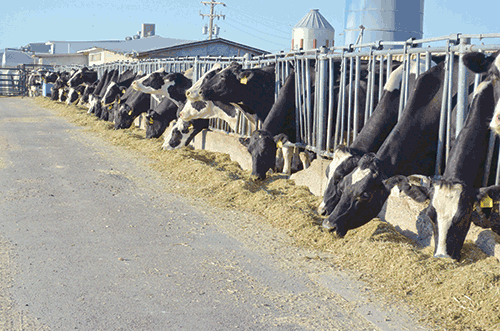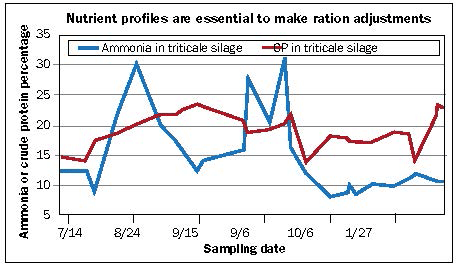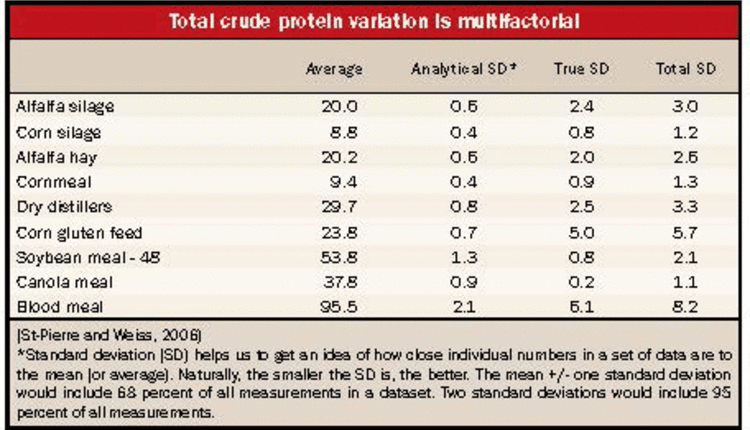
Feed and forage nutrient composition always vary to some degree. But limiting ration variability can improve cow health and productivity. Feed costs are generally higher when variability of farm forages and feed ingredients are high. This is because rations must be balanced for higher nutrient concentrations (overformulated) as insurance against nutrient deficiency in the event that unrecognized nutrient content changes occur.
Especially with rations balanced for high production, a change in forage fiber content can be critical. Raising ration fiber levels can limit intake and production. But lowering ration fiber levels may compromise rumen health and productivity.
Shrinks with replication
Feed economics are challenging the dairyman and nutritionist to be aggressive in monitoring changes in feedstuff composition and respond with ration adjustments. However, if not approached properly, you risk making ration changes too frequently elevating costs and adversely affecting cow performance.
Bill Weiss, The Ohio State University, speaking at the recent Cornell Nutrition Conference, advised against making decisions about forage and ration changes based on a single feed analysis. Research that he and others are involved with at Ohio State on feed variation shows that variability in corn silage and hay crop silage from day to day is often as large as month-to-month variation.
Weiss states that "single samples should not be relied upon to provide an accurate description of the feed." He advocates using results from two or three samples taken within a short period of time and averaging. These average values would be used in ration formulation. This approach allows your nutritionist to make changes based on true compositional change rather than being whipsawed by normal variation.
Whereas in the past a producer routinely sampled all forages once or twice per month, now a more analytical approach is recommended to decide how frequently to send in samples. If the nutrient analysis changes, consideration should be given to whether this new analysis is used in ration balancing or because of random variation, if it would be better to use the average of multiple samples.
If change is occurring in a given forage material, and the normal sampling regimen is every two weeks and it takes one week to obtain results from the laboratory (including shipment time), then there may be significant error in properly characterizing a feed material from a single test.
Using well-calibrated NIRS (Near-Infrared Spectroscopy) analysis procedures rather than wet chemistry, more samples can be tested at the same cost. The average of the multiple samples by NIRS is typically better than the wet chemistry analysis of one sample. Because of the extra sampling, it is possible to monitor and define feedstuff variation and reduce the number of ration changes.

Track nutrient changes
NIRS is the backbone of an intensive testing program as it is the only technology that can deliver large amounts of feed analytical information quickly and cost effectively. What NIRS may lack in accuracy compared to reference procedures, it makes up for with elevated precision.
NIRS is used as a tool throughout many industries as part of process control as it does an excellent job of recognizing change. NIRS can be applied to the evaluation of feed variation in the same manner. Intensive testing of forages and TMR allows a manager to define variation, recognize when true change occurs and use this information in decision analysis.
Sampling frequency using a process control approach on farm will vary depending on the number of cows fed, the number of feeds, usage rate of each feed and the normal variation in that feed. The objective of a process control approach is to sample frequently enough to define routine variation and to be able to recognize when significant change occurs.
Several labs have established printouts or decision analysis software to more easily recognize and alert a manager when significant change occurs. Labs are developing reports that create a weighted average of multiple feed analyses that can be generated as a nutrient profile for ration balancing purposes. Laboratories will be providing more decision analysis tools for forage and feed information management in the future.

Variation is inherent
The nutrient composition of some feeds and forages varies more than others. For example, by-product feeds like blood meal and corn gluten feed will vary more in their nutrient content than corn and soybean meal.
According to The Ohio State University researchers, accounting for sources of "fixed" variation, such as separating forages by hybrid or cutting and sorting distillers grains by source, can help reduce the amount of variation that will otherwise be assumed to be "random." The table shows that total variation is the sum of compositional variation and analytical variation.
The figure shows nutrient changes over time in triticale silage from a large dairy. The percentage of protein in a forage sample as ammonia is a good means of inferring fermentation quality. Higher levels of ammonia are associated with clostridial fermentations and the production of amines.
Clostridial forages can depress intake and elevate blood ketone levels. One may be able to correlate higher ammonia levels in the triticale silage as causative of a higher incidence of ketosis or displaced abomasums that might otherwise go unresolved.
The percentage of crude protein (CP) in the triticale silage ranged from 14 to 24 percent with change in the bunk sometimes occurring very quickly. Obviously, the quicker this change is recognized and ration adjustments can be made, the better.
Your nutritionist and laboratory can help you understand the expected mean and ranges for nutrients in purchased commodities. These will change depending on the feed, region and season. When high variation is expected, more analysis is needed.
This article appears on page 289 of the April 25, 2013 issue of Hoard's Dairyman.








